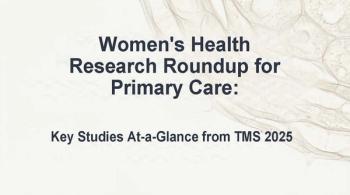
Medication Errors in Adults: Case #6: Insulin
Confusion about multiple insulin products; nonadherence to the prescribed regimen; the patient’s injection technique . . . here: a look at why errors occur when insulin is prescribed-and how to prevent them.
Medication errors may occur at any point in the health care system. Obtaining a true estimate of the number of errors is difficult, but preventable medication errors are known to increase patient harm and total health care costs.1
This series will highlight some of the most important drug errors and address methods to decrease the risk of them occurring. In the first article, I addressed a common error associated with warfarin.2 The second article focused on a common error that involved acetaminophen and duplicate therapy.3 In the third article, I addressed a common error associated with duplicate therapy.4 The fourth article discussed a common error with chemotherapy drug interactions.5 In the fifth article, I looked at potential errors related to pharmacotherapy in patients with renal insufficiency.6 This sixth article describes errors associated with insulin.
Case #6: Insulin
A 54-year-old man with a past medical history of hypertension, hyperlipidemia, and type 2 diabetes mellitus (DM) presents to the clinic for follow-up of his DM. He reports several episodes of hyperglycemia, and his hemoglobin A1c level has increased from 7.1% to 8.2% (American Diabetes Association goal, less than 7.0%). His medications include lisinopril, 10 mg/d; atorvastatin, 20 mg/d; Lantus, 30 units qhs; and Apidra, 10 units tid AC. He reports that he often does not take his vials and syringes with him when he goes out to eat for lunch with his colleagues from the office or to dinner with his wife; however, he is otherwise adherent with his insulin doses.
What is the problem in this scenario?
Discussion
Insulin is one of the medications included on the Institute for Safe Medication Practices List of High-Alert Medications in Community/Ambulatory Healthcare.7 Medications on this list, if used in error, increase the risk of causing significant harm. Insulin, with its narrow therapeutic window, places the patient at increased risk for hypoglycemia or hyperglycemia.
With insulin therapy, much effort has been placed on the need to prevent errors by avoiding error-prone abbreviations, such as “U,” when handwriting insulin prescriptions because this may cause confusion regarding the prescribed dose.8 Errors associated with this abbreviation have resulted in significant patient harm or death resulting from an insulin overdose. Although this is an extremely important error and should be avoided by writing the word “unit” on handwritten prescriptions for insulin, other errors may also occur with insulin at both the provider and patient levels.
In the case above, the patient is nonadherent to doses of his rapid-acting, mealtime insulin Apidra, as noted by his admission of skipping doses when he goes out to eat. His barriers to adherence likely include the ease of administration in public and potential social anxiety from administering insulin in public. This patient-level error has resulted in hyperglycemia in this patient and contributed to his uncontrolled hemoglobin A1c level.
In addition to the error this patient reported, it is important to evaluate each patient’s insulin injection technique because errors in administration (eg, rotating and appropriate sites, pinch-up, timing of dose) also may result in uncontrolled blood glucose levels.9,10 To avoid these types of patient errors, each patient must be educated appropriately on DM as well as the administration of insulin. An interdisciplinary approach, using DM educators, dieticians, nurses, and pharmacists, may provide the most assistance and best prevent errors associated with the patient’s technique and nonadherence.
At the provider level, it is important to consider potential insulin errors and ways to avoid them. In the case above, insulin pen devices may be a more appropriate choice than syringes/vials for this patient because pen devices may allow for easier administration of doses, especially mealtime insulin. In addition, pen devices may increase adherence while addressing many of the potential barriers associated with insulin use.11 As stated above, educating the patient to fully understand the use of these devices and the importance of adherence is imperative.
Additional errors can result from multiple insulin products, which can confuse both patients and physicians. Solutions to avoid errors involve education and, if necessary, prescribing products from different insulin manufacturers (eg, Novo Nordisk, Sanofi Aventis, Eli Lilly) because products such as Lantus and Apidra from the same manufacturer in the example case above look similar. This could cause confusion to the patient and result in the wrong product being given at the wrong time.
Confusion among physicians also may occur because of the many different insulin products (eg, Humulin or Novolin 70/30, Humulin or Novolin R and N) and the multiple look-alike, sound-alike names (eg, HumuLIN and HumaLOG).12 Physicians should confirm the product the patient is using to consistently provide the same insulin product.
Disclosures:
References
1. Institute of Medicine. To Err Is Human: Building a Safer Health System. Washington, DC: National Academy Press; 1999.
2.
3.
4.
5.
6.
7. Institute for Safe Medicine Practices. ISMP List of High-alert Medications in Community/Ambulatory Healthcare.
8. Institute for Safe Medication Practices. ISMP’s List of Error-Prone Abbreviations, Symbols, and Dose Designations.
9. De Coninck C, Frid A, Gaspar R, et al. Results and analysis of the 2008-2009 Insulin Injection Technique Questionnaire survey. J Diabetes. 2010;2:168-179.
10. Partanen TM, Rissanen A. Insulin injection practices. Pract Diab Int. 2000;17:252-254.
11. McCoy EK, Wright BM. A review of insulin pen devices. Postgrad Med. 2010;122:81-88.
12. Institute for Safe Medication Practices. ISMP’s List of Confused Drug Names.
Newsletter
Enhance your clinical practice with the Patient Care newsletter, offering the latest evidence-based guidelines, diagnostic insights, and treatment strategies for primary care physicians.
























































































































































































































































































